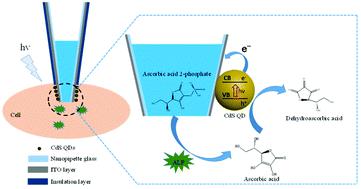Our official English website, www.x-mol.net, welcomes your feedback! (Note: you will need to create a separate account there.)
Photoelectrochemical analysis of the alkaline phosphatase activity in single living cells
Analyst ( IF 4.2 ) Pub Date : 2021-08-10 , DOI: 10.1039/d1an01273h Nina Wang 1 , Rongrong Pan 1 , Lina Ji 2 , Dechen Jiang 1 , Hong-Yuan Chen 1
Analyst ( IF 4.2 ) Pub Date : 2021-08-10 , DOI: 10.1039/d1an01273h Nina Wang 1 , Rongrong Pan 1 , Lina Ji 2 , Dechen Jiang 1 , Hong-Yuan Chen 1
Affiliation

|
Conventional photoelectrochemical (PEC) analysis mostly utilizes photoactive material modified planar indium tin oxides (ITOs) to obtain photocurrent responses for the measurement of analytes in solution. In this work, a CdS quantum dot (QD) modified nanopipette was prepared for the PEC analysis of the alkaline phosphatase (ALP) activity in single MCF-7 cells. The nanopipette was filled with ascorbic acid 2-phosphate (AAP) that was egressed outside the nanopipette by electrochemical pumping. Next, AAP was catalyzed by ALP to generate ascorbic acid (AA), which is an efficient electron donor for CdS QDs under illumination. Based on the result that the nanopipette showed a linear photocurrent response to AA, a nearly linear correlation between the photocurrent and the activity of ALP was established. Accordingly, using these CdS QD modified nanopipettes, the ALP activity in single MCF-7 cells was determined to be 0.12 U mL−1 by PEC analysis. This work does not expand the application of PEC bioanalysis, but offers a new strategy for single cell analysis.
中文翻译:

单个活细胞碱性磷酸酶活性的光电化学分析
传统的光电化学 (PEC) 分析主要利用光活性材料改性的平面氧化铟锡 (ITO) 来获得用于测量溶液中分析物的光电流响应。在这项工作中,制备了 CdS 量子点 (QD) 修饰的纳米移液器,用于单个 MCF-7 细胞中碱性磷酸酶 (ALP) 活性的 PEC 分析。纳米移液管充满抗坏血酸 2-磷酸 (AAP),通过电化学泵将其排出纳米移液管外。接下来,AAP 被 ALP 催化产生抗坏血酸 (AA),它是光照下 CdS QD 的有效电子供体。基于纳米移液管对 AA 显示出线性光电流响应的结果,建立了光电流与 ALP 活性之间几乎线性的相关性。因此,-1通过 PEC 分析。这项工作并没有扩展 PEC 生物分析的应用,而是为单细胞分析提供了一种新的策略。
更新日期:2021-09-01
中文翻译:

单个活细胞碱性磷酸酶活性的光电化学分析
传统的光电化学 (PEC) 分析主要利用光活性材料改性的平面氧化铟锡 (ITO) 来获得用于测量溶液中分析物的光电流响应。在这项工作中,制备了 CdS 量子点 (QD) 修饰的纳米移液器,用于单个 MCF-7 细胞中碱性磷酸酶 (ALP) 活性的 PEC 分析。纳米移液管充满抗坏血酸 2-磷酸 (AAP),通过电化学泵将其排出纳米移液管外。接下来,AAP 被 ALP 催化产生抗坏血酸 (AA),它是光照下 CdS QD 的有效电子供体。基于纳米移液管对 AA 显示出线性光电流响应的结果,建立了光电流与 ALP 活性之间几乎线性的相关性。因此,-1通过 PEC 分析。这项工作并没有扩展 PEC 生物分析的应用,而是为单细胞分析提供了一种新的策略。

























 京公网安备 11010802027423号
京公网安备 11010802027423号